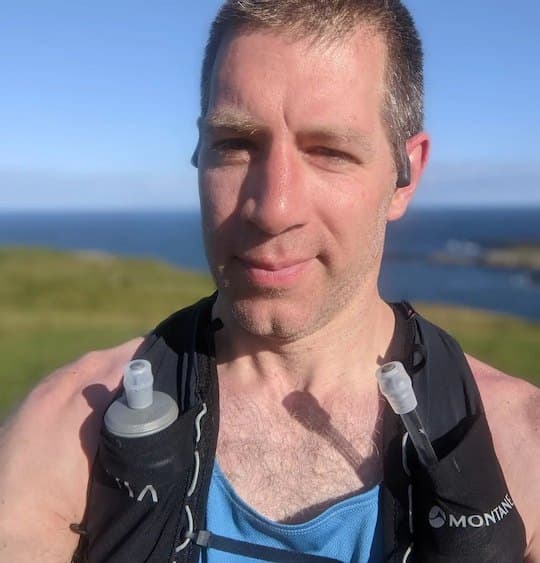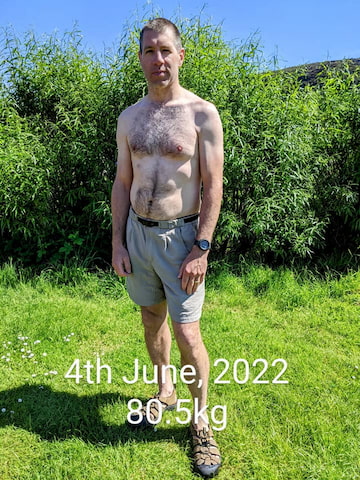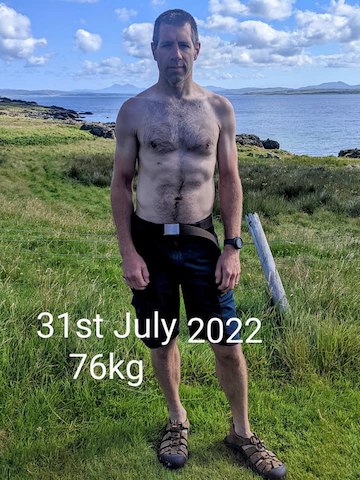29th August, 2022
Intro
A change from digital discussions, here is how I got in to running. Being a runner is not that unlike running a website. It is easy to launch a website out in to the world, as easy as heading out your front door for a run. All it takes is the decision to do it. However, to do either successfully (especially when you start running in middle age) you need data, you need a lot of attention to detail, you need to bring a number of disparate elements together; you need a plan. There are quite a few numbers mentioned below, but I make no apologies for that, it is what works for me.
3rd of October Update: It has been 6 months since I started running, here is a summary: My first 6 months of progress as a runner.

That was then.
This year, I turned 46. I spent most of my late teens doing martial arts and working out, then in my twenties I spent most of my time mountaineering and climbing. In my thirties, work took priority, and then I got married and had two kids.
While we did a lot of outdoors stuff as a family, I had assumed that I had passed my physical peak. While not unfit
, I was destined to slowly become less fit and
accumulate the odd additional kilo of weight and centimetre of waist as the years ticked by. I regularly cycled 16 miles to work and back, but I was no athlete.
This is now.
There was a moment. It was at approximately 7am on the 25th of March, 2022, about the time the background image of this page was taken.
There's a company rule at Tiso where you have to take your birthday off as a holiday. To be honest, I'm not one for really celebrating my birthday, but I decided to not waste the opportunity and take a bit of time for me. As the weather has been so good recently, I got up just after 6 and headed out on the mountain bike. The spot where this photo was taken is about 45 min pedal from home. It felt so good to be out in the outdoors, moving through the country, exercising. I resolved there and then that I was going to get fit again; I wanted to do this for me. Something just clicked inside me.
As I mentioned at the start, I did cycle to work on a regular basis. However, unfortunately my commuter bike was off the road due to a warranty issue, with no clear timeline as to when I was getting it back. So, I thought the most practical thing to do while I awaited its return was to start running. I had previously had a few short spells of running over the years, but it never really stuck. I fully expected to drop the running once I had the bike back.
The starting point
While not unfit, I was no athlete. And I was certainly overweight. I am 180cm tall, and at the end of March I was 86.3kg, which is a BMI of 26.6. I had also recently heard the assertion that a better indication of health than BMI was waist to height ratio. To be considered healthy, your waist should be less than half your height, I started my journey with a 93cm waist. At the start of April, I measured my resting heart rate at 53 BPM.
So, I was going to run, and I was going to get fitter. But I was going to need some help. I know from previous experience that I enjoyed tracking performance, I used Strava to track my rides to work to measure improvement. While that was fine for measuring times and distances, I wanted more data so I bought a Garmin Instinct Solar GPS watch with built-in heart rate monitor. I'll cover more on what I get from the watch a bit further down, but suffice it to say, it feels like one of the best value for money purchases I have made in a long time.
Let's hit the road!
My plan to run wasn't very sophisticated to start with. I decided to go out, see if I could manage a short distance and then build up to 5km. In my mind, 5km was the goal. I did my first run on the 2nd of April, it was 3.5km, it took me 20:09 (which is a 5:40/km pace); I managed to run the whole way without resorting to walking, which I was quite pleased at even if I felt like I was ready to collapse.
The next run was four days later, same route. This time I took 19:46. I could live with a 23s improvement. Again, I'm happy just to be able to run the whole way.
The following Saturday I decided to just go for the 5km and see how I get on. Well, I ran it. 34.46, a pace of 6:08/km. Yes, I was slow. That was no surprise, but what was surprising was that I actually enjoyed doing it.
Back in the saddle
In mid-April I got the bike back, sick of sitting in traffic on the way to work, I was keen to get back to cycle-commuting to work.
But the question was, could I combine cycling the 16 miles each way to work with running? And would I still want to run now that I was back cycling?
I quickly came to realise that the two could be complimentary but that getting good at running was a higher priority for me, so I would need to make my cycling fit around my running. My running plan was that I would run twice a week, a Saturday and Wednesday morning — I worked from home every Wednesday. I could then cycle in to work two or three days a week, but I would need to take it easy on the bike to allow my legs to rest.
Getting smarter, getting faster
By early May, I was getting in my groove. I was consistently running 5km in under 25 minutes, within 5 weeks my pace had gone from a 5:40/km pace down to 4:49/km. I started to believe I could actually achieve a sub-20min 5km, which would be amazing!
I had also been working on my nutrition. I started taking a recovery drink after ever run or ride (I use SIS Rego), and had started
tracking my calorie intake using MyFitnessPal. Calorie counting has really worked for me, I have tried to be as honest and accurate as possible,
I have found it to be a great way to hold myself to account. I have drastically cut down on my alcohol intake, I have had 22 units since the 26th of March.
I wasn't really a big drinker before this, I would regularly do dry January and more, but I've now taken it a step further.
My main reason for reducing my alcohol intake was that I wanted to do all I could to improve my sleep, and as I was wearing the Garmin watch
all the time I couldn't hide from the fact that alcohol reduces your sleep quality. It was also another way to reduce my calorie intake.
I maybe wasn't an alcoholic, but I was (am?) a chocoholic. I could eat Dairy Milk as fast as you could hand it to me. But chocolate is now mostly gone from my diet,
basically I decided it just wasn't worth it. Mark Lewis, a fitness Youtuber
frames this really well, he says: when you are thinking about eating something, consider whether you need it or just want it. If you just want it,
that's fine, but you need to accept the consequences of eating it
I found that a really empowering statement.
As well as my nutrition I have been focused on recovery. In fact, I think the only way I have been able to make the improvements I have seen is
because I have taken recovery seriously. Of course, nutrition (and hydration) are vital for recovery, sleep and rest are also vital. My watch tracks
my body energy levels, using a metric called Body Battery
. The watch measures my Heart Rate Variation, this is different to Heart Rate as it is
not a measure of how fast your heart beats but how variable the time is between beats. When fatigued, the timing between beats has a lot of variation,
when you are rested you have a more regular rhythm. If my body battery starts the day low, then I will change my exercise plans, maybe take an extra
rest day. I also spend time every day stretching. I have a routine before bed, I put on some relaxing music and use a foam roller on my legs, I use
a Triggerpoint. It helps my legs and helps my sleep. I have also bought a massage gun, which gets to the spots that I find difficult with the roller,
I have a Pulseroll Mini Massage gun and have found it invaluable for combating delayed onset muscle soreness.
I mentioned above that I was also cycling, well this has become an important part of my running progress. I use cycling as active recovery sessions, where I keep my heart rate lower. It keeps the blood flowing in my legs, which helps their recovery, but it also provides some additional base cardio load but without any impact on the joints.
Lastly on the subject of becoming a smarter runner, I have been spending more time consuming running and fitness content. There are many
great fitness YouTube channels, Mark Lewis being just one. There are also a lot of great blogs out there. I'll compile a list and add it to the bottom.
One thing I learned is that I should be running slower to get faster
, basically do more miles but at a slower pace to build base fitness
and strength, and you also recover quicker than making every run about doing maximum effort.
I have found that I have really enjoyed the methodical nature of training smart. When I was younger, I used to just go and do whatever activity and then just eat pizza afterwards. But as I have gotten older, I have realised that if I don't approach this correctly I will either a) do myself some serious harm that may have long-term consequences and/or b) I'll not make optimum progress towards my goals
I started this journey at 86.3kg, I wish I had taken a picture of my "before" state, but here is one of me half way to my target of sub-75kg.

Going the distance
So after hearing about running slower to get faster, at the start of June I decided I would up my miles. The general advice is that you should only increase your volume by no more than 10% each week. My plan was to continue to run twice a week, stick to 5km on the Wednesday morning but then stretch out the distance on the Saturday morning. Within a couple of weeks the Saturday run had gotten up to 12km, and I felt great! I think this is where things started to come unstuck.
I was enjoying my 12km route so much that I decided I would also start running it on a Wednesday morning. That didn't seem to cause me any issues, so I started adding 10% to my Saturday runs. I had a new goal: work up to being able to run 21.1km every weekend. It seemed totally within reach, but also quite a cool personal milestone: going from not being a runner to someone who runs a half marathon every week.
I started building the distance, within a couple of weeks I was running 18km on a Saturday. I had also started going to Yoga, as I had some ongoing knee discomfort which I wanted to shift.
A house of sand
In mid-July, Buoyed by my running success, I was keen to push another -complimentary- area of fitness, namely mobility and core strength. It was week two of attending yoga, and like most activities I tried to give it my all. Basically, I over-did it, and injured my left hip flexors, although I didn't realise it at the time.
Next on my running schedule was my first 21km run, scheduled 3 days after the yoga. I got about half way round and started to feel pain in my hips. But, I pushed on. I completed the run in 2:04, much slower than I had hoped for. By the time I got home, my left hip was all but immobile. I was a bit sore the next day, but thankfully I wasn't too bad just walking about. I decided to skip my mid-week run in the hope that I would have recovered enough to do a long run the following weekend, we were heading on holiday and I had planned a really nice route.
That next long run was pretty much a re-run of the previous. Hip pain started kicking in half way, I persisted and managed to get 20km done. But I really was sore the next day. It was time to reduce my mileage and put more effort in to strengthening my hip flexors and improving their flexibility. I had pushed my mileage up too fast and not built up a base of strength and flexibility in all the minor muscle groups.
Here' a picture of me on that holiday, having lost another 4kg from the start of June.

Baby steps
At time of writing, end of August, I am still running twice a week. But it is only 6km, and the pace is not what it once was. However it is improving again. And the hip pain is easing, slowly. I'm still doing yoga.
As the running mileage has dropped, I'm not burning as many calories, so I have had to be more careful about what I eat. Still, I have managed to get my weight down to around where I planned, I am currently at 74kg and my waist is 81cm. I could afford to lose just a little more, which might be helpful in reducing the strain on my joints (and hip flexors).
In summary
I love running! I love the rhythm, the flow. I like knowing that I'm so much fitter than I was, that I can do big days out in the hill and enjoy them more as the miles come easier. I love being out and travelling through the countryside. I feel empowered by the choice I have made to get fit and for sticking at it. I have run over 300 miles so far this year and I really hope to be a runner for a long time.
If you're not a runner but would like to get fitter, I would very much commend running to you. You don' need to run far (to start with) or fast, but you will feel great for doing it!